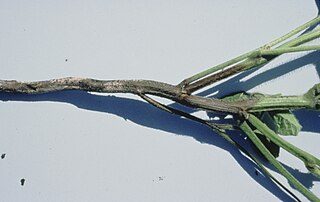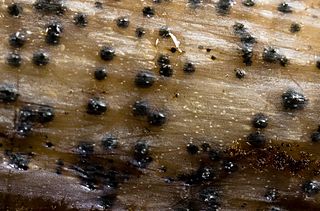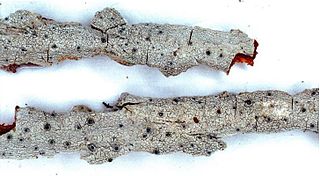
A legume is a plant in the family Fabaceae, or the fruit or seed of such a plant. When used as a dry grain, the seed is also called a pulse. Legumes are grown agriculturally, primarily for human consumption, for livestock forage and silage, and as soil-enhancing green manure. Well-known legumes include beans, soybeans, chickpeas, peanuts, lentils, lupins, grass peas, mesquite, carob, tamarind, alfalfa, and clover. Legumes produce a botanically unique type of fruit – a simple dry fruit that develops from a simple carpel and usually dehisces on two sides.

Cercospora is a genus of ascomycete fungi. Most species have no known sexual stage, and when the sexual stage is identified, it is in the genus Mycosphaerella. Most species of this genus cause plant diseases, and form leaf spots. It is a relatively well-studied genus of fungi, but there are countless species not yet described, and there is still much to learn about the best-known members of the genus.

Phytophthora megasperma is a species of water mould in the family Peronosporaceae. It is well known as a plant pathogen with many hosts. It often causes a plant disease called root rot.
Uromyces striatus is a fungal species and plant pathogen causing rust in Medicago species.

Pleospora herbarum is a species of fungus in the family Pleosporaceae. It is a plant pathogen infecting several hosts including alfalfa, apples, asparagus, tomatoes, citruses and chickpea. It has a cosmopolitan distribution, and is common in temperate and subtropical regions. The fungus was first described under the name Sphaeria herbarum by Christian Hendrik Persoon in 1801.
Stemphylium alfalfae is a plant pathogen infecting alfalfa.
Stemphylium globuliferum is a plant pathogen infecting alfalfa.

Stemphylium solani is a plant pathogen fungus in the phylum Ascomycota. It is the causal pathogen for grey leaf spot in tomatoes and leaf blight in alliums and cotton, though a wide range of additional species can serve as hosts. Symptoms include white spots on leaves and stems that progress to sunken red or purple lesions and finally leaf necrosis. S. solani reproduces and spreads through the formation of conidia on conidiophores. The teleomorph name of Stemphyllium is Pleospora though there are no naturally known occurrences of sexual reproduction. Resistant varieties of tomato and cotton are common, though the pathogen remains an important disease in Chinese garlic cultivation.

Stemphylium vesicarium is a plant pathogen infecting many plants including onion, garlic, asparagus, and pear.
Alternaria senecionis is a fungal plant pathogen, can cause leaf spot on Cineraria species, such as on Senecio cruentus in Denmark.
Urocystis occulta is a smut fungus which attacks the leaves and stalks of rye.

Pleosporaceae is a family of sac fungi. They are pathogenic to humans or saprobic on woody and dead herbaceous stems or leaves.

Zerene cesonia, the southern dogface, is a North and South American butterfly in the family Pieridae, subfamily Coliadinae.

Uromyces is a genus of rust fungi in the family Pucciniaceae. The genus was described by Franz Unger in his 1833 work Die Exantheme der Pflanzen. They have a worldwide distribution but large occurrences happen in North America and Europe.

Pleospora is a genus of ascomycete fungi. This genus was originally described by Gottlob Ludwig Rabenhorst in 1857 and was revised by Wehmeyer and Müller. There was an estimated 63 species in 2008. As of 8 August 2023, the GBIF lists up to 440 species, while Species Fungorum lists about 375 species.

Anticarsia gemmatalis is a tropical species of caterpillar and moth that migrates north each season. The species can commonly be found in the Gulf states, north as far as Wisconsin. The adults have wings that are grayish brown, crossed with brown or black zigzag lines. The caterpillars are black or green, with narrow lighter stripes on the back and sides. They spit out a brownish substance, spring into the air and wriggle a lot when they are disturbed. The species eats velvet beans, peanut, soybeans, cotton, kudzu, alfalfa, cowpeas, horse beans, snap beans, lima beans, and coffeeweeds. Its common name is velvetbean caterpillar and velvetbean moth.

Stictis is a genus of lichenized fungi in the family Stictidaceae.

Physoderma is a genus of chytrid fungi. Described by German botanist Karl Friedrich Wilhelm Wallroth in 1833, the genus contains some species that are parasitic on vascular plants, including P. alfalfae and P. maydis, causative agents of crown wart of alfalfa and brown spot of corn, respectively. Of the chytrid genera, Physoderma is the oldest. However, species were confused with the rust fungi, the genus Synchytrium, and the genus Protomyces of Ascomycota. Members of Physoderma are obligate parasites of pteridophytes and angiosperms. There are approximately 80 species within this genus.
Harzia acremonioides is a species of seed-borne fungus that occurs in the soil. It has been categorized in the Ceratostomataceae family and under the genus Harzia. The genus Harzia contained up to three accepted species: H. acremonioides, H. verrucose, and H. velatea in 1974. Within the genus Harzia, H. acremonioides is one of the most common species that can be found in all climate regions around the world.
Dothidea is a genus of fungi belonging to the family Dothideaceae. The genus was first described in 1818 by Elias Magnus Fries. The type species is Dothidea sambuci.












